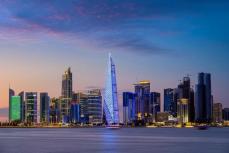Blog • Published on:September 23, 2025 | Updated on:September 25, 2025 • 15 Min
Wealthiest Caribbean Nations in 2025 by GDP and Economic Growth
The Caribbean is often associated with its picturesque beaches and vibrant cultures, but beneath the surface lies a complex and evolving economic landscape. While tourism remains a significant contributor, the region's economies are increasingly influenced by sectors such as energy, finance, and agriculture.
In 2025, the Caribbean has experienced varied economic growth rates. Guyana stands out with impressive growth driven by its burgeoning oil industry. In contrast, other nations like The Bahamas and Jamaica saw more modest growth rates.
In this blog, we delve into the economic dynamics of the Caribbean, examining GDP figures, key sectors, and investment opportunities.
Overview of the Caribbean Economic Landscape
Caribbean economies show mixed performance in 2025 due to structural differences. Here's a snapshot of macroeconomic indicators across key nations:
- Guyana: Projected 2025 GDP growth of 10.3% predicted to rise to 23% in 2026, inflation 3.6%, unemployment 13%, driven by oil and gas (approximately 10% of GDP).
- Dominican Republic: Forecasted 2025 4.0% growth tipped to increase to match 2024’s 5% in 2026, 4% inflation, 5.3% unemployment; a mix of tourism and manufacturing.
- The Bahamas: 1.8% growth, 0.9% inflation, 9.3% unemployment; services dominate.
- Jamaica: 2.1% growth, 5.0% inflation, 4.2% unemployment; tourism and BPO-led.
- Trinidad & Tobago: 2.4% growth, 1.3% inflation, 4.1% unemployment; energy sector dominant.
- Barbados: 3.0% growth, inflation 2%, unemployment 7.8%.
Wealthiest Caribbean Nations by GDP
Trinidad and Tobago: Energy-Driven Industrial Base
What drives Trinidad and Tobago’s economy? The foundation is hydrocarbons. As the region's leading exporter of liquefied natural gas (LNG), Trinidad and Tobago also produces petrochemicals like ammonia and methanol, supporting a strong manufacturing base.
2025 Highlights:
- Nominal GDP: $26.47 billion
- Per Capita GDP: $18,440
- Primary Sectors: LNG, oil, petrochemicals, manufacturing
Trinidad and Tobago's industrial economy offers more diversification compared to its tourism-dependent neighbors.
The Bahamas: High-Income Services Economy
How does The Bahamas generate its wealth? Tourism and financial services account for 70% of national output. The Bahamas hosts numerous international banks, trusts, and fund entities.
2025 Highlights:
- Nominal GDP: $15.18 billion
- Per Capita GDP: $36,780
- Visitors: Over 11 million in 2024
- Primary Sectors: Tourism (50%), Financial Services (20%)
Despite a population of only around 413,400, The Bahamas ranks among the Caribbean’s richest countries in per capita terms.
Jamaica: Services and Stability
What’s fuelling Jamaica’s resilience? Business process outsourcing (BPO), logistics, remittances, and a steady tourism recovery contribute to growth.
2025 Highlights:
- Nominal GDP: $21.41 billion
- GDP Growth: 2.1%
- Unemployment: 4.2%
Jamaica’s debt-to-GDP ratio has dropped from 150% in 2013 to 62.4% today.
Barbados: Mid-Shore Business and Tourism
Why is Barbados considered stable? Barbados offers a hybrid model of tourism and corporate services, backed by a well-regulated tax regime and international treaty network.
2025 Highlights:
- Nominal GDP: $7.55 billion
- GDP Growth: 3%
- Unemployment: 7.8%
- Focus Sectors: Agriculture, manufacturing, and services
GDP Comparison
Key Economic Sectors in the Caribbean
Tourism and Hospitality Industry
How important is tourism to Caribbean economies?
Tourism remains the largest contributor to GDP in many Caribbean nations. In 2025, most countries have returned to or exceeded their pre-pandemic tourism volumes, led by The Bahamas, Saint Lucia, and Barbados.
Leading Tourism-Dependent Nations (2025)
Notable trends:
- A shift toward luxury and experiential travel is displacing low-margin mass tourism.
- Digital nomad visas in Barbados and Antigua and Barbuda are extending average stays and local spend.
- Eco-tourism is expanding in countries like Dominica and Saint Vincent and the Grenadines with international development backing.
Financial Services and Banking
Which countries lead in financial services?
Three financial jurisdictions remain dominant: The Bahamas, Barbados, and the Cayman Islands. All have moved toward transparency while maintaining core advantages for wealth planning and fund management.
OECD and FATF reforms have made these markets more regulated yet still appealing to compliant international investors.
Natural Resources and Energy
Who are the region’s energy exporters?
Natural resource wealth is highly concentrated in three countries.
Guyana's continued production boom is projected to make it the largest economy in CARICOM by 2035, based on current trends.
Agriculture Exports
How relevant is agriculture in today’s Caribbean?
Agriculture contributes modestly to GDP, but it is vital for rural employment and food security.
Key Agricultural Export Products by Country:
- Jamaica: Blue Mountain Coffee
- Dominican Republic: Bananas, sugar, cocoa
- Saint Vincent and the Grenadines: Sweet potatoes, bananas
- Belize: Citrus fruits, corn
Sector challenges and responses:
- Climate-smart techniques are being adopted to handle extreme weather events.
- Governments are investing in irrigation, protected farming, and resilient seed systems.
- Local food production is being promoted to reduce import dependency.
GDP Per Capita Rankings in the Caribbean
GDP per capita offers a clearer picture of individual economic well-being than total GDP. In 2025, Guyana’s oil boom and The Bahamas’ high-income service economy top the rankings.
Top Caribbean Nations by GDP Per Capita
What are the current economic growth trends?
- Guyana continues to lead regional growth through sustained energy exports and infrastructure development.
- The Bahamas and Aruba benefit from high-spending visitors and mature financial services.
- Barbados and Trinidad and Tobago show consistent performance driven by economic reform and energy exports.
- The Dominican Republic maintains upward momentum via manufacturing and real estate development.
How is income distributed across the region?
Income distribution varies widely:
- High-income economies: The Bahamas, Trinidad and Tobago, and Barbados reflect higher living standards and service-sector resilience.
- Middle-income economies: The Dominican Republic show steady per capita growth with improving infrastructure and labor conditions.
- Lower-income economies: Dominica remains remain tourism-dependent and vulnerable to climate shocks.
Efforts to narrow income inequality include:
- Diversifying into tech and renewable energy
- Expanding vocational training
- Targeted SME support and financial inclusion programs
Investment Opportunities in Caribbean Nations
Real Estate Development
Real estate is a long-standing favourite among foreign investors, driven by demand for second homes, luxury resorts, and rental properties in high-tourism areas.
In 2025, markets like The Bahamas, Antigua and Barbuda, and Saint Lucia are witnessing renewed investor interest, particularly in branded residences and private coastal developments.
What’s trending?
- Eco-integrated projects are becoming more common in Saint Lucia and Dominica.
- Branded residences linked to major hotel chains are expanding in The Bahamas and the DR.
- Yield-driven buyers are prioritizing islands with tourism recovery and short-term rental demand.
Tourism Infrastructure
As tourism rebounds in 2025, several governments are prioritizing infrastructure improvements, airports, cruise terminals, and marinas, to support increased visitor capacity and diversify tourist offerings.
Investors are partnering with local developers or tapping into public-private partnerships (PPPs), especially where tourism is a GDP anchor. Long-term returns are being driven by resilient demand for luxury, wellness, and adventure travel.
Financial Services
The Caribbean's offshore and business services markets are undergoing transformation, stricter regulation, digital onboarding, and FATF compliance have created a new wave of “clean money” investment.
Key trends in 2025:
- Digital compliance tech is reshaping onboarding and KYC.
- Family office formation is rising in the Cayman Islands and The Bahamas.
- Blockchain-based asset custodians are emerging in more crypto-friendly jurisdictions.
Citizenship by Investment Programs in the Caribbean
Saint Kitts & Nevis
- Sustainable Island State Contribution (SISC): Minimum non-refundable donation of $250,000.
- Real Estate Investment: Minimum investment of $325,000 in government-approved real estate projects.
Antigua & Barbuda
- National Development Fund (NDF) Donation: Minimum contribution of $230,000 for a single applicant.
- Real Estate Investment: Minimum investment of $300,000 in approved real estate projects.
- Business Investment: Minimum of $1.5 million for a single investor or $400,000 per investor in a joint investment totalling at least $5 million.
Dominica
- Economic Diversification Fund (EDF) Donation: Minimum contribution of $200,000 for a single applicant.
- Real Estate Investment: Minimum investment of $200,000 in government-approved real estate projects.
Grenada
- National Transformation Fund (NTF) Donation: Minimum contribution of $235,000 for a single applicant.
- Real Estate Investment: Minimum investment of $270,000 in government-approved real estate projects.
Many choose to retire, invest, or gain a second citizenship in the Caribbean, especially with its growing economic appeal and lifestyle benefits. Read our blog to find out which Caribbean island is best for you
Economic Challenges and Solutions
How do natural disasters impact Caribbean economies?
Natural disasters are among the most significant threats to economic stability in the Caribbean. Hurricanes, floods, and droughts disrupt tourism, agriculture, and infrastructure, often wiping out the equivalent of multiple years of GDP in smaller islands.
2025 Preparedness Trends:
- Disaster risk financing initiatives are expanding, such as the CCRIF SPC parametric insurance scheme.
- Infrastructure hardening programs, backed by the World Bank and Caribbean Development Bank, are underway.
- Climate-smart agriculture and renewable energy investments are being scaled to improve resilience.
Why is economic diversification essential?
Many Caribbean nations still rely on one or two major sectors, typically tourism or energy. This makes them vulnerable to demand shocks, pandemics, and global commodity swings.
Key initiatives in 2025:
- Tech innovation parks are being piloted in Jamaica and Barbados.
- Fintech licenses and crypto regulation are becoming mainstream in The Bahamas and Antigua and Barbuda.
- Blue economy strategies (sustainable ocean use) are gaining traction in Grenada and Saint Vincent and the Grenadines.
What are the current trade and investment policy challenges?
Trade access and logistics are persistent bottlenecks for small island states. Many nations depend heavily on imports (fuel, machinery, food) and are exposed to currency and freight volatility.
Regional policy responses:
- CARICOM Single Market and Economy (CSME) aims to increase intra-regional labour mobility and business scaling.
- OECS (Organization of Eastern Caribbean States) promotes shared legal and regulatory standards.
- Bilateral trade deals with the EU, Canada, and China are being revisited to improve terms.
Caribbean Financial Centers
While tourism gets the headlines, financial services quietly underpin the economies of several Caribbean nations. The region has long attracted global investors, high-net-worth individuals, and corporate entities for one main reason: it offers low-tax or no-tax environments combined with access to sophisticated legal and financial systems.
In 2025, this reputation still holds, but the rules of the game have changed. International pressure, especially from the OECD and FATF, has pushed Caribbean financial centers to tighten compliance, improve transparency, and shed the old “tax haven” label.
The Bahamas: Private Wealth and Trust Services
Core Focus Areas:
- Private banking and trust formation
- Wealth management for ultra-high-net-worth individuals
- Family offices and estate planning
2025 Developments:
- The Bahamas continues to enforce strict KYC and AML protocols, while maintaining client confidentiality.
- The Central Bank’s digital currency (the Sand Dollar) is being used to test digital identity frameworks for financial services.
- No income, capital gains, or inheritance tax remains a key attraction.
Barbados: Business Structuring with Treaty Benefits
Core Focus Areas:
- International Business Companies (IBCs)
- Corporate tax structuring
- Insurance, reinsurance, and investment funds
Unique Features:
- Barbados is one of the few Caribbean jurisdictions with a strong network of double taxation treaties, including with Canada, the UK, and several EU countries.
- Offers special regimes for global business corporations with effective tax rates between 1%–5.5%, depending on profits.
- Promotes itself as a “mid-shore” jurisdiction, not purely offshore, but with strong regulatory legitimacy.
Antigua and Barbuda: Digital Asset Licensing and Offshore Banking
Growing Niches:
- Fintech and blockchain-based financial services
- Offshore banks catering to emerging markets
- Second passport banking options for CBI clients
Recent Moves:
- Antigua and Barbuda has introduced digital asset licensing legislation aimed at attracting crypto-based banking and custody services.
- Offshore banks now require enhanced capital reserves and are regularly audited to meet FATF standards.
- The country ties offshore banking perks with its Citizenship by Investment program, making it a strategic asset for global entrepreneurs.
Future Economic Prospects
What development projects are underway in the Caribbean?
Across the region, governments and private investors are investing heavily in infrastructure, renewable energy, and digital connectivity. These aren’t abstract plans, they’re active projects reshaping the economic trajectory of the islands.
Key Projects to Watch in 2025:
- Guyana’s Gas-to-Energy Project: With ExxonMobil's backing, this $2 billion+ project is expected to reduce local electricity costs by over 50% and boost industrial development.
- Barbados' Scotland District Rehabilitation: A $230 million initiative (funded by the Caribbean Development Bank) to prevent coastal erosion, improve roadways, and create sustainable rural employment.
- Jamaica’s South Coast Highway Expansion: Scheduled to be complete by March 2027 thanks to the government committing $2.5 million from the 2025-2026 budget, this will improve logistics, reduce travel time, and support export industries.
- Dominica’s Geothermal Energy Project: Aims to power 100% of the country with renewable energy and reduce electricity costs by over 40%.
What are the growth forecasts for the region?
Economic performance in the Caribbean is expected to remain strong in specific areas, though growth will be uneven across countries. Here’s a general view of 2025–2027 outlooks:
- Guyana is projected to continue double-digit GDP growth thanks to oil production. While current growth is slowing slightly from 2023 highs, it's still forecast above 10% annually through 2027.
- Dominican Republic is expected to maintain consistent annual growth of 4%–5%, driven by manufacturing, exports, and domestic consumption.
- Barbados and Jamaica show moderate but steady growth, estimated at 2.5%–3% annually, supported by tourism, remittances, and services.
- Trinidad and Tobago is forecast to grow at around 2.5% per year, though performance will depend on energy markets and progress in diversification.
Key drivers of regional growth include:
- Foreign Direct Investment in energy, real estate, and tourism infrastructure
- Public-private partnerships (PPPs) in transportation and logistics
- Digital transformation initiatives in banking, public administration, and education
- Climate resilience projects financed by multilateral lenders and green bonds
Impact of Global Events on Caribbean Economies
How has the Caribbean recovered from the pandemic?
While COVID-19 disrupted tourism and supply chains across the region, most Caribbean economies have now rebounded, though at different speeds.
- Tourism-led economies like The Bahamas, Barbados, and Saint Lucia have recovered 85–100+% of their pre-pandemic visitor arrivals by early 2025, thanks to pent-up travel demand and stronger airlift connections.
- Digital services and business process outsourcing (BPO) helped cushion economies like Jamaica and the Dominican Republic, which were able to pivot to remote work industries faster than others.
- Debt levels, however, remain elevated in many countries. For example, public debt in Barbados remains above 100% of GDP, limiting fiscal space for further stimulus or social spending.
Post-pandemic reforms include:
- Digitization of public services (e.g., e-passports, online business registration)
- Investment in healthcare infrastructure and social safety nets
- Expansion of flexible visa/residency programs targeting digital nomads and long-stay tourists
What is the economic cost of climate change?
The Caribbean faces disproportionately high climate risks. Rising sea levels, stronger hurricanes, and erratic rainfall directly affect tourism, agriculture, and infrastructure.
Key impacts observed:
- Loss of coastal land threatens key tourism assets like beachfront resorts and ports.
- Agricultural disruptions from unpredictable weather patterns have reduced food security and exports.
- Reconstruction costs after major storms often exceed 10%–15% of national GDP in smaller islands.
Countries like Dominica, Saint Vincent and the Grenadines, and Antigua and Barbuda are investing in climate-resilient infrastructure, including elevated roadways, hurricane-proof hospitals, and green energy systems. The Green Climate Fund (GCF) and Caribbean Development Bank (CDB) are actively supporting these efforts with grants and concessional loans.
How do global market trends affect Caribbean economies?
As small, open economies, Caribbean nations are highly sensitive to global market fluctuations:
- Interest rate hikes in the US have increased borrowing costs across the region, especially for countries that issue USD-denominated debt.
- Inflation in global commodity markets (especially food and fuel) has driven up import bills for most islands, pushing consumer prices higher.
- Tourism flows depend heavily on the health of the North American and European middle classes, making the region exposed to foreign recessions.
Supply chain fragility has also emerged as a long-term concern. The pandemic revealed the Caribbean’s overreliance on distant suppliers for essential goods. In response, several islands are now emphasizing:
- Nearshoring (sourcing goods closer to home)
- Regional food production cooperatives
- Investment in cargo port upgrades to improve trade efficiency
What’s Next for the Caribbean?
The Caribbean in 2025 is no longer just a vacation spot, it’s becoming one of the world’s most dynamic micro-economies.
Oil discoveries are transforming countries like Guyana into future energy giants. Tech and financial services are diversifying economies once reliant solely on tourism. Infrastructure projects, green energy programs, and regional trade reforms are creating new investment windows that didn’t exist a decade ago.
For global investors, business owners, and families looking for a stable second base, the Caribbean offers something rare: political stability, tax-friendly structures, and lifestyle appeal, all on a backdrop of economic transformation.
If you’re considering second citizenship, residency, or investment in the Caribbean, whether for lifestyle, wealth planning, or long-term security, Savory & Partners can guide you through it.
FAQs on Caribbean Economies, Investment, and Growth
1. Which Caribbean country has the highest GDP per capita in 2025?
The Bahamas currently holds the top position in the Caribbean for GDP per capita in 2025, estimated at $36,780.
2. What’s the fastest-growing Caribbean economy in 2025?
Guyana is the fastest-growing economy, with a projected GDP growth rate of over 10% this year. Its oil production, led by ExxonMobil and its partners, has transformed the country from one of the poorest to the richest in the region within five years.
3. Which Caribbean countries attract the most foreign investment?
The Dominican Republic, Guyana, and The Bahamas are currently leading in foreign direct investment (FDI) inflows. These investments are focused on:
- Oil & energy infrastructure (Guyana)
- Tourism resorts, ports, and manufacturing (Dominican Republic)
- Luxury real estate and fintech (The Bahamas)
4. What’s the best Caribbean country for real estate investment?
It depends on your goals:
- For luxury beachfront property: The Bahamas (Nassau, Paradise Island)
- For value and future appreciation: Dominican Republic (Punta Cana, La Romana)
- For eco-tourism and boutique developments: Saint Lucia and Dominica
- For investment plus residency/citizenship: Antigua & Barbuda and Saint Kitts & Nevis
5. Are Caribbean offshore financial centers still viable in 2025?
Yes, but the game has changed.
- The Bahamas and Barbados remain strong financial jurisdictions.
- Regulations have tightened, all are now FATF and OECD-compliant.
- The emphasis is shifting from anonymity to structured, legal tax efficiency, especially for wealth planning, funds, and asset protection.
6. How are Caribbean economies preparing for climate change?
Most countries are investing in climate-resilient infrastructure, renewable energy, and sustainable agriculture. Key actions include:
- Geothermal energy development (Dominica)
- Disaster insurance pools through CCRIF SPC
- Green climate funds used for sea wall and flood control projects
- Sustainable tourism planning in Saint Vincent and the Grenadines, Saint Lucia, and Grenada
References
International Monetary Fund (IMF). (2024). World Economic Outlook: Caribbean regional tables and analysis. Retrieved from https://www.imf.org/en/Publications/WEO
United Nations Economic Commission for Latin America and the Caribbean (ECLAC). (2024). Economic Survey of Latin America and the Caribbean 2024. Retrieved from https://www.cepal.org/en/publications
World Bank. (2024). Caribbean Regional Economic Review: Resilience, Growth, and Opportunity. Retrieved from https://www.worldbank.org/en/region/lac
Caribbean Development Bank (CDB). (2025). Annual Economic Review and Forecast Report. Retrieved from https://www.caribank.org/publications-and-resources
Written By

Laura Weber
Laura Weber is a legal expert in international tax planning and citizenship by investment. With over a decade of experience, Laura helps individuals and families navigate complex legal frameworks to secure dual citizenship and global residency options, particularly in the Caribbean and Europe.
Related Articles









Recently Published









Book a free consultation


